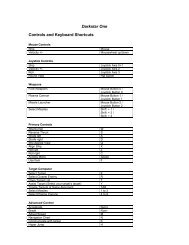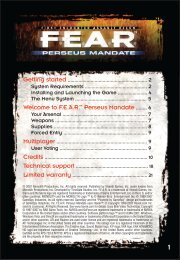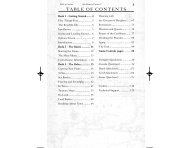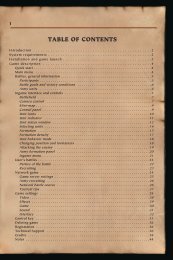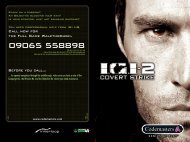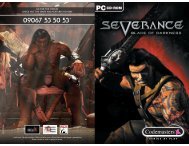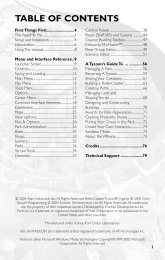Heads-Up Display Modes 35 - Metaboli
Heads-Up Display Modes 35 - Metaboli
Heads-Up Display Modes 35 - Metaboli
You also want an ePaper? Increase the reach of your titles
YUMPU automatically turns print PDFs into web optimized ePapers that Google loves.
Air Combat Basics 127<br />
of time between rolling away from the target until pulling back into the target<br />
determines how “big” the yo-yo is. Generally speaking, executing a series of<br />
small yo-yo’s to slowly nibble away at a large angular problem is better than<br />
executing one large maneuver.<br />
If you have an adversary executing high yo-yo’s behind you in order to gain a firing<br />
position, watch the enemy’s nose closely. Your movement away from him helps<br />
solve his closure rate or aspect angle problem. Whenever his nose comes off (that<br />
is, is pointed behind your flight path), relax your turn and accelerate, thus<br />
increasing your energy status. As his nose pulls back into firing position, increase<br />
the g-load and tighten your turn. Conserve your energy when his nose is off,<br />
spend your energy as he brings his nose toward a firing position.<br />
Aerial Gunnery<br />
Firing a gun from a moving platform, and trying to hit another moving platform<br />
executing evasive maneuvers, is no trivial task. To begin with, the bullets take a<br />
finite amount of time to leave the barrel and travel to the target; the further away<br />
the target is, the longer each projectile takes to cover the distance. During that<br />
time of flight, the target will probably execute some form of evasive maneuver; he<br />
probably won’t be in the projectile’s flight path by the time it gets there. So, the<br />
shooter has to “lead” the target: predict where it will be by the time the bullets<br />
get there and then fire at that point, hoping the target flies into the projectile<br />
stream. Meanwhile, gravity tugs on the projectiles, pulling them toward the<br />
ground. The farther and slower the projectile flies, the more the bullets drop. The<br />
shooter must factor this drop into the lead calculations as well.<br />
Meanwhile, the shooter is moving also. Since he’s chasing the target, he’s<br />
probably flying a curved flight path. Consequently, his tracer stream appears to<br />
“bend” away since the individual rounds continue on a straight flight path. If all<br />
goes according to plan, the shooter aims ahead of the target, fires, and watches<br />
the tracers appear to fly a curved path to intercept the target.<br />
Based on this scenario, we see that the range to the target is arguably the most<br />
important aspect of aerial gunnery. The further away the target is, the longer the<br />
bullets fly. Consequently, the shooter must lead the target more and account for<br />
greater drop due to gravity. As most WWII pilots (who did not have the benefit of<br />
pickling off a guided missile) discovered, don’t shoot until the enemy aircraft fills<br />
the view. The closer you are, the more likely you’ll hit something. Deflection<br />
shooting, or the art of appropriate leading a maneuvering target, increases in<br />
difficulty as range-to-target increases.





